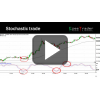Latest Trader Channel Posts
The Averages Must Confirm Each Other
Dow Theory was referring to the Industrial and Rail averages. The theory states that no important bull or bear market signal can take place unless both averages give the same signal. This meant that a bullish breakout on the Industrial average was only valid if a similar bullish breakout occurred on the Rail average.
In today's market this relationship still exists. The Dow Jones, FTSE 100, CAC 40, Nikkei... are all related to a certain extent. Therefore it is necessary to analyse more than one market for confirmation. Stock indexes should be analysed on a daily basis. What I am looking for is some confirmation signals between the S&P 500 and the FTSE 100. When I trade the FTSE 100 I analyse the FTSE 100 and the S&P 500 for confirmation.
Divergences
A divergence occurs when one market is moving up or down while the other is moving in the opposite direction or going sideways. For instance, if the S&P 500 is making new highs and the FTSE 100 is trading sideways or going down, caution should be the rule. The indexes are giving contradictory signals, so traders should stand aside until both indexes give the same signal.
This situation occurred recently after a long advance. In general when a divergence occurs between two indexes following a long rally, it is a warning that the trend will reverse.
The FTSE 100 peaked on 14th March and began making lower lows. While the FTSE 100 was making lower lows, the S&P 500 was making new highs.
The top in the S&P 500 came more than two weeks later. This divergence between the FTSE 100 and the S&P 500 was a warning that the rally was running out of steam.
See more articles from Thierry Laduguie on www.bettertrader.co.uk











